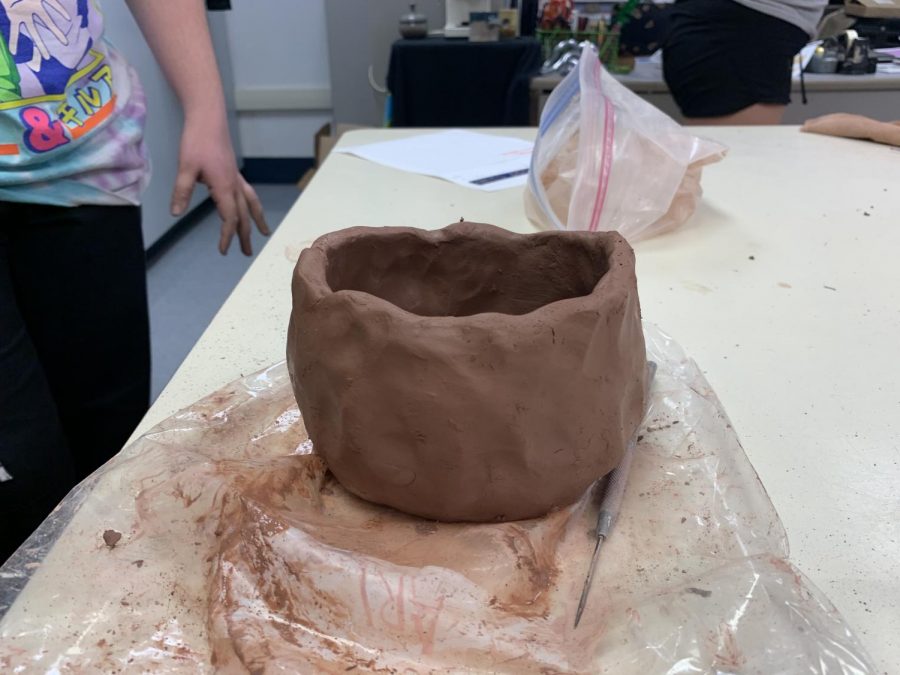My journey with a pinch pot
November 22, 2021
Trying new things is an essential part of life. Especially in making art, which I plan to do as my career, you have to try new things frequently or your art will become stagnant and bland. But there are times that I resist trying new things because of their difficulty. I often resist the most when it comes to one medium: clay.
I love making art, don’t get me wrong, but I’ve always struggled when it comes to clay. It doesn’t like me, and I don’t like it. The clay dries over my hands, cracks, and makes my skin feel rough and dirty. I hate the sensation. What I do love is drawing and painting, making collage, and pretty much anything that doesn’t involve making pots. But, in AP Art History, that’s precisely what I had to do.
I think I said “Oh no” out loud. A few years ago, I took a wheel throwing class with a stern, tough-love teacher who didn’t give much patience to her students. I remember hearing “the bottom is too thick!” at least a thousand times, and having to restart a broken pot or a pot that became uncentered at least another thousand times. My history with clay is not one of love and endearment.
I started with the large block of clay, smashing it between my two hands, trying to wedge it on the table. The block was hard and firm, and hurt my hands to mold. I kept wedging regardless, until my hands were caked with mud and the previously firm block gave in like Play-Doh, not without the help of some water. I then began the process of creating a pinch pot. I shoved my thumbs in the top of the lop-sided sphere I made. I pulled the sides of the “pot,” which was currently a lump of clay with a thumb-shaped hole in it, trying to make the walls of the pot. I tried to push my fingers together through the sides of the clay, sculpting strong, medium-thickness walls with a thin-but-hefty bottom and even lip.
It started off okay, then I sculpted a little bit too much. The walls at the top looked more like pieces of paper than pieces of clay because of how thin I had made them. The lip went up and down like a roller coaster, and no matter how much I tried to fix it, it was to no avail. I attempted to fold over the lip and even it out; that made everything worse. My pot was beyond saving. I had to start over.
So I went at it again, wedging and throwing the clay in my hands and on the table. Eventually, I wedged it long enough that I could convince myself it no longer had any air pockets in it, and I submerged my thumbs in it yet again. I started out with thinning the walls, and soon enough, I ran into the same problem I did before. I made the walls way too thin again, and there was no fixing it except for starting over.
Yet again, I wedged the clay, molding it into a firm ball. I told myself this would be the last time I would start over. I couldn’t put myself through this again. I wedged the clay, formed it into a ball, and pressed my thumbs into it. By the end of the period, I had formed an uneven, asymmetrical pot, but a pot nonetheless.
Next class, I went to work on making the bottom thinner. Unfortunately, my pot didn’t survive this process. I made the bottom too thin, creating a hole. It was time to start over yet again, but now there was no more class time to work on our pots. I had to find my own time to work on my clay creation.
I set my sights on Mud Club, an after-school activity where you work on clay. I’d never been before, but I figured it was the perfect, and only, opportunity I would get to perfect my pot. So the next Tuesday after school, I set out to Mrs. Caruso’s room. I grabbed my pinch pot (still a ball of clay) and began. I wedged it, molded it, and jabbed my fingers into it. I sculpted the walls, I thinned out the bottom. I was out of my comfort zone, but everything was going well. The walls were at their perfect thickness. The bottom wasn’t too thick, but not too thin either. The lip was a bit curvy, but not too curvy that it would be unusable. I decided to let go and “finish” my pinch pot, to leave it be as it was right then so I didn’t mess it up any further.
In the winter, I will be raku firing my pot with the rest of my Art History class. I’m not sure what I’m going to use my pot for, but I’m definitely going to keep it as a personal reminder of hardship and overcoming it.
For all the angst that went into it, I can’t just get rid of it. Even if it serves me as a pencil holder, my time, effort, and tears will serve me well.
You’ll have to do it in every aspect of life you encounter, whether it be work, school, or something else. While I wasn’t perfect at this new activity, and I probably will never make a pinch pot willingly again, I’m glad I stuck with it and saw it through to the finish, even though it caused me so much turmoil and time.











